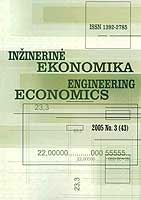Changes in the Imposition of Value Added Tax in Lithuania (1994-2004)
Changes in the Imposition of Value Added Tax in Lithuania (1994-2004)
Author(s): Gintaras Šaparnis, Danutė BendikienėSubject(s): Economy
Published by: Kauno Technologijos Universitetas
Keywords: imposition; tax; budget; inflow; law; VAT rate; VAT object; VAT deduction; VAT overpay-ment; Sale VAT; Purchase VAT.
Summary/Abstract: Value added tax (VAT) was introduced in Lithuania in May 1, 1994. It replaced basic excise duty. Basic ex-cise duty rate was 15 per from 1991, and from July 1, 1992 it was 18 per cent. For the goods sold in foreign countries for convertible currency the rate was 10 per cent When the VAT law came into force (Žin., 1994, Nr. 3-40) two rates were applied: 18 per cent on all goods and services, except VAT-exempt, and 0 per cent on ex-ported goods and services. Value added tax was not im-posed on food, fuel, coal, gas and heating of dwelling houses, education, health care, social, transport and other services. However, from January 1, 1995, tempo-rary 9 per cent rate was already imposed on food. From 1995 VAT became the main source of national budget and made up 34.3 per cent of all inflow, and in 1997 it was already 40.6 per cent, because temporary VAT rate for food was doubled (from 9 per cent to 18 per cent) and the basis of assessment was widened. The reduced 5 per cent rate was first applied in 2000. From May 1, 2000 it was imposed on shuttle passenger transport services. The reduced 9 per cent rate was in-cluded in the VAT law only in 2001: it was imposed on heating energy provided for inhabitants. According to the provisions of the VAT law, VAT payers pay to the state budget the difference between calculated tax sum for sold goods (services) and the sum of the tax paid for goods (services) provided by suppliers. Applying different rates, VAT rebate is paid to VAT payers. So the application of the reduced rates reduces VAT inflow to the state budget. Since July 1, 2002 the new VAT law came to force (Žin., 2002, Nr. 35-1274). The European Union (EU) directives were already implemented and certain VAT exemptions continued to be removed: 5 per cent rate was imposed on part of medicine and medical services, 18 per cent rate was imposed on veterinary services, in-service training and reskilling services, land for construction and selling new buildings. 5 per cent rate was imposed on books, newspapers and magazines, and 18 per cent rate on newsprint in 2003. When Lithuania became European Union Member State, from May 1, 2004 the new redaction of the VAT law came to force. The provisions of the Sixth Directive of the EU were implemented in it. The exemptions on biofuel and heating of dwelling houses, 5 per cent rate was imposed on medicine and medical services, 18 per cent rate was im-posed on scientific research. Other important changes not related to VAT exemptions also occurred.
Journal: Engineering Economics
- Issue Year: 2006
- Issue No: 2 (47)
- Page Range: 23-29
- Page Count: 7
- Language: English

